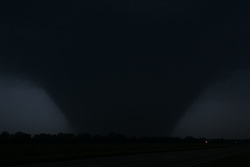Tornado outbreak of March 3–4, 2030: Difference between revisions
Tags: Mobile edit Mobile web edit |
Tags: Mobile edit Mobile web edit |
||
| Line 77: | Line 77: | ||
National Weather Service Damage Surveyors would rate a structure with a 220 mph damage indicator, the highest damage indicator ever assigned in the modern era. They noted foundation dislodging, along with the anchor bolts being pulled from the ground. Parts of the foundation were pulled out of the ground and cracked, along with extreme windrowing of its debris miles downwind. | National Weather Service Damage Surveyors would rate a structure with a 220 mph damage indicator, the highest damage indicator ever assigned in the modern era. They noted foundation dislodging, along with the anchor bolts being pulled from the ground. Parts of the foundation were pulled out of the ground and cracked, along with extreme windrowing of its debris miles downwind. | ||
Quote from a NWS Surveyor: | '''Quote from a NWS Surveyor:''' | ||
“It was unlike anything I have ever seen. I’ve had my fair share of rating tornadoes, along with doing the research of the strongest tornadoes to ever exist. This is certainly close, if not overtaking the damage done in Smithville, Mississippi in 2011. This damage was by far, some of the worst I’ve ever seen in my entire life…” | ''“It was unlike anything I have ever seen. I’ve had my fair share of rating tornadoes, along with doing the research of the strongest tornadoes to ever exist. This is certainly close, if not overtaking the damage done in Smithville, Mississippi in 2011. This damage was by far, some of the worst I’ve ever seen in my entire life…” '' | ||
{{Clear}} | {{Clear}} | ||
Revision as of 23:43, 1 ⧼august⧽ 2025
| No image provided | |
| Meteorological history | |
|---|---|
| Duration | March 3–4, 2030 |
| Tornado outbreak | |
| Tornadoes | 2 |
| Maximum rating | EF5 tornado |
|
| |
| Highest winds | Tornadic - 210 mph (340 km/h) (Dodge Center, Minnesota EF5 on March 3) |
| Overall effects | |
| Fatalities | Unknown |
| Injuries | Unknown |
|
| |
| Part of the Tornadoes of 2030 | |
Meteorological synopsis
Confirmed tornadoes
| EFU | EF0 | EF1 | EF2 | EF3 | EF4 | EF5 | Total |
|---|---|---|---|---|---|---|---|
| 0 | 0 | 0 | 0 | 1 | 0 | 1 | 2 |
Ackerman–Sturgis–Bradley–Longview–Starkville–Mayhew–Eskridge, Mississippi
| No image provided | |
| Meteorological history | |
|---|---|
| EF3+ tornado | |
| on the Enhanced Fujita scale | |
| Overall effects | |
| Fatalities | 3+ |
| Injuries | 85+ |
A large, long-track and potentially violent tornado struck the communities of Bradley, Longview, and Starkville in Mississippi directly during the late night hours of March 3. The tornado would damage, or completely destroy multiple structures in it's path. Doppler radar measured a gate to gate velocity on this tornado of 245 mph (394 km/h). Starkville was the worst hit, with the tornado directly impacting the downtown district. The tornado would track over 50 miles across northeastern Mississippi and remain on the ground for over an hour.
There have been reports of slabbed homes within the city, but damage surveys are still ongoing. Preliminary surveys indicated this tornado was at least low-end EF3 intensity. Each county affected have yet to post their death/injury totals as they are still unknown. Latest information shows that over 85 people were injured according to the public along with 3 known fatalities.
Hartland–Ellendale–Bixby–Dodge Center–Mantorville–Douglas, Minnesota
 A picture of the tornado nearing Dodge Center | |
| Meteorological history | |
|---|---|
| Formed | March 4, 2030, 12:31 a.m. CST (UTC-6:00) |
| Dissipated | March 4, 2030, 1:24 a.m. CST (UTC-6:00) |
| EF5 tornado | |
| on the Enhanced Fujita scale | |
| Highest winds | 220 mph (350 km/h) |
| Overall effects | |
| Fatalities | 67 |
| Injuries | 152 |
A very large, long-track, and extremely violent tornado struck the city of Dodge Center, Minnesota on the early morning hours of March 4, 2030. This tornado would travel for nearly 60 miles across southeastern Minnesota and be on the ground for nearly an hour. 67 fatalities and 152 injuries occurred during this tornado.
Shortly after the tornado’s formation, surveyors noted that this tornado underwent extreme intensification early in its life and already committed significant ground scouring less than 15 seconds of being on the ground. As it approached the city of Dodge Center, it would scour the ground so violently that it dug a 4 foot deep trench in the soil, and shredded all vegetation at the surface.
As the tornado impacted Dodge Center, Meteorologists at the NWS office in Chanhassen, Minnesota noted a large debris signature within the cell as it entered the city. Radar estimates concluded that debris was launched nearly 80,000 feet into the atmosphere. Citizens who took shelter within the tornado’s path noted that they felt an extreme pressure drop that ruptured root canals, ripped tear duxes, pulling of muscles, and even causing slight dislocations of shoulders.
After the tornado, response was immediate. Storm spotters were the first among emergency services to arrive in the devastated city. They would report that the city was completely unrecognizable. One survivor said “It was like a nuclear bomb went off and erased everything”. Emergency services had trouble locating trapped victims due to the extreme damage. Finding the death toll took nearly 2 weeks due to how shredded and broken the city was.
National Weather Service Damage Surveyors would rate a structure with a 220 mph damage indicator, the highest damage indicator ever assigned in the modern era. They noted foundation dislodging, along with the anchor bolts being pulled from the ground. Parts of the foundation were pulled out of the ground and cracked, along with extreme windrowing of its debris miles downwind.
Quote from a NWS Surveyor: “It was unlike anything I have ever seen. I’ve had my fair share of rating tornadoes, along with doing the research of the strongest tornadoes to ever exist. This is certainly close, if not overtaking the damage done in Smithville, Mississippi in 2011. This damage was by far, some of the worst I’ve ever seen in my entire life…”
